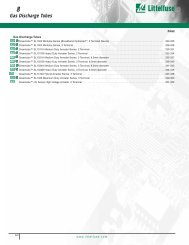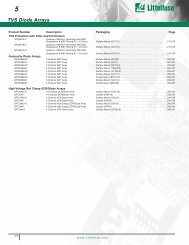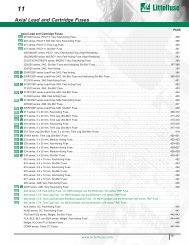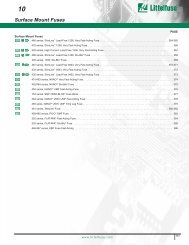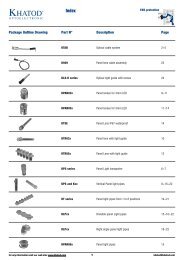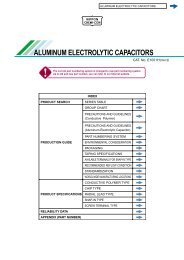You also want an ePaper? Increase the reach of your titles
YUMPU automatically turns print PDFs into web optimized ePapers that Google loves.
<strong>Varistor</strong> <strong>Products</strong><br />
High Surge Current, Radial Lead<br />
UltraMOV <strong>Varistor</strong> Series<br />
Device Ratings and Specifications (Continued)<br />
MODEL<br />
NUMBER<br />
DEVICE<br />
MODEL<br />
NUMBER<br />
BRANDING<br />
MAXIMUM RATING (85 o C) SPECIFICATIONS (25 o C)<br />
CONTINUOUS TRANSIENT<br />
RMS<br />
VOLTS<br />
DC<br />
VOLTS<br />
ENERGY<br />
2ms<br />
VM(AC) VM(DC) WTM (V) (V) (J)<br />
PEAK CURRENT<br />
8 x 20µs<br />
I TM<br />
1 x PULSE<br />
(A)<br />
I TM<br />
2 x PULSE<br />
V10E550 10V550 550 745 90 3500 2500 819 1001 1500 25 100<br />
V14E550 14V550 550 745 180 6000 4500 819 1001 1500 50 180<br />
V20E550 20V550 550 745 360 10000 6500 819 1001 1500 100 300<br />
V10E625 10V625 625 825 100 3500 2500 900 1100 1650 25 90<br />
V14E625 14V625 625 825 200 6000 4500 900 1100 1650 50 160<br />
V20E625 20V625 625 825 400 10000 6500 900 1100 1650 100 250<br />
NOTE:<br />
1. Average power dissipation of transients should not exceed 0.25W, 0.4W, 0.6W and 1.0W for 7mm, 10mm, 14mm, and 20mm model sizes,<br />
respectively.<br />
Power Dissipation Ratings<br />
Should transients occur in rapid succession, the average power dissipation<br />
is the energy (watt-seconds) per pulse times the number of pulses<br />
per second. The power so developed must be within the specifications<br />
shown on the Device Ratings and Specifications table for the specific<br />
device. Furthermore, the operating values need to be derated at high<br />
temperatures as shown in Figure 1. Because varistors can only dissipate<br />
a relatively small amount of average power they are, therefore, not<br />
suitable for repetitive applications that involve substantial amounts of<br />
average power dissipation.<br />
PERCENT OF PEAK VALUE<br />
100<br />
O 1<br />
90<br />
50<br />
10<br />
T<br />
T1 T 2<br />
TIME<br />
www.littelfuse.com<br />
VARISTOR<br />
VOLTAGE AT 1mA<br />
DC TEST CURRENT<br />
V NOM<br />
MIN<br />
MAXIMUM<br />
CLAMPING<br />
VOLTAGE 8 x 20 µs<br />
TYPICAL<br />
CAPACI-<br />
TANCE<br />
V NOM<br />
MAX V C I PK f = 1MHz<br />
(A) (V) (V) (A) (pF)<br />
PERCENT OF RATED VALUE<br />
100<br />
90<br />
80<br />
70<br />
60<br />
50<br />
40<br />
30<br />
20<br />
10<br />
0<br />
-55 50 60 70 80 90 100 110 120 130 140 150<br />
AMBIENT TEMPERATURE ( o C)<br />
FIGURE 1. CURRENT, ENERGY AND POWER DERATING<br />
CURVE<br />
O 1 = Virtual Origin of Wave<br />
T = Time From 10% to 90% of Peak<br />
T 1 = Virtual Front time = 1.25 • t<br />
T 2 = Virtual Time to Half Value (Impulse Duration)<br />
Example: For an 8/20µs Current Waveform:<br />
8µs = T 1 = Virtual Front Time<br />
20µs = T 2 = Virtual Time to Half Value<br />
FIGURE 2. PEAK PULSE CURRENT TEST WAVEFORM<br />
39<br />
2<br />
VARISTOR<br />
PRODUCTS




